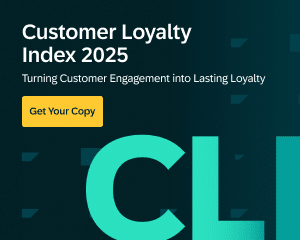Are your marketing reports actually helping your teams make better decisions, or are they adding more noise to the pile?
It’s no secret: Marketers today have no shortage of data. Every campaign, channel and tactic brings with it a stream of metrics. However, without the right reporting capabilities in place, most teams spend more time pulling numbers than actually acting on the insights hidden behind them.
The problem is that most reporting and analytics tools stop at telling you what happened, when the real value lies in the why. Without that, you lack the intel you need to know what you should do next.
Your customer reporting capabilities need to do more for you. They need to highlight what’s working, flag what isn’t, and help your team tie activities to outcomes – whether that’s engagement, revenue or retention.
In this article, we’ll explore eight essential AI marketing reporting and analytics capabilities your marketing team needs to move faster, drive performance, and operate in an omnichannel environment with confidence.
1. Real-Time Dashboards Across All Channels
Static dashboards have their place, but in fast-moving environments, they get outdated quickly. If your team is making decisions based on yesterday’s data, you’re already one step behind.
That’s why real-time dashboards are essential. They give you a live view of performance across all your channels such as email, push and digital ads, in one place. No toggling between tools, no manually stitching data together, and no waiting for weekly reports.
Look for a platform that offers not just real-time reporting, but configurable dashboards too. You should be able to drill down into individual campaigns, compare performance by segment or objective, and surface the metrics that matter most to your team.
How Emarsys helps: SAP Emarsys provides real-time, customisable dashboards that consolidate data across all your channels. Marketers can filter views by campaign, audience or business unit, making it easy to monitor performance and optimise in the moment.
2. Customer Lifecycle And Revenue Attribution Reporting
Open rates and click-throughs tell you whether people saw your message. They don’t tell you whether your marketing drove revenue or repeat purchases. To make better decisions, you need customer reporting that connects engagement data to lifecycle movement and commercial outcomes.
A strong reporting layer should let you see how different lifecycle stages perform over time, like:
- New leads converting to first purchase
- First-time buyers becoming repeat customers
- Active customers lapsing
- Lapsed customers returning
When you can track volume, value and velocity at each of these transition points, you can spot weak links in your customer journey and reassign budget to areas with the greatest upside.
Revenue attribution is equally important here. You should be able to understand which campaigns, channels, and segments contribute to orders, average order value, customer lifetime value, and downstream retention. The right platform should give you both views: a clear look at individual customer journeys, and the ability to tie every campaign back to revenue impact.

How SAP Emarsys helps: SAP Emarsys links campaign engagement to lifecycle progression and revenue outcomes. Marketers can analyse conversions from first purchase through repeat orders, report on revenue attribution across channels, and build cohort views that show the long-term value of different campaigns or segments. These insights make it easier to prioritise programs that grow customer lifetime value, not just top-line response rates.
3. Built-In, Cross-Channel Campaign Analytics
If your reporting only shows how each channel performs in isolation, you’re missing the bigger picture. Modern customer journeys span multiple touchpoints, and your analytics should reflect that.
Look for campaign reporting that connects performance across email, SMS, push, digital ads, and web. You should be able to see which channel combinations are driving conversions, where there is overlap or fatigue, and how each message contributes to the overall goal.
Campaigns should also be measurable by outcome. Whether your objective is first purchase, reactivation, or upsell, your reporting should surface what worked, where, and why.
How SAP Emarsys helps: SAP Emarsys gives marketers cross-channel campaign analytics in a single, unified view. You can report by channel, objective, or segment, and see how touchpoints are working together to drive results, not just clicks.

4. Segment And Audience-Level Reporting
Not all customers behave the same, so your reporting shouldn’t treat them like they do. You need to know how different audiences engage, convert, and retain over time.
Segment-level reporting helps you answer key questions. Which customer groups are most responsive? Where is churn happening? Are high-value segments growing or shrinking?
You should be able to compare engagement, conversion, and revenue performance across different lifecycle stages, loyalty tiers, product affinities, or behavioural traits and use those insights to personalise future campaigns.

How SAP Emarsys helps: With SAP Emarsys, marketers can view performance by segment, cohort, or audience type. You can quickly see which groups are responding, which are stalling, and where to focus next, all without needing manual analysis.
5. Predictive Insights And AI Recommendations
Good reporting tells you what happened. Great reporting helps you plan what to do next.
That’s the promise of AI marketing reporting: combining predictive insights with automation to surface opportunities before they happen. Predictive insights give your team a head start. Instead of reacting to past results, you can anticipate customer behaviour, like which segments are likely to churn, who’s ready to buy again, or which products are gaining momentum.
Even better if your platform can surface recommendations automatically. That means less guesswork, faster optimisation, and campaigns that hit the mark sooner.

How Emarsys helps: SAP Emarsys includes AI-powered marketing reporting and predictive models that highlight opportunities and risks, from churn forecasts to next-best actions. It also suggests prebuilt tactics to help you act on insights instantly.
6. Custom Reporting That Doesn’t Require IT
You shouldn’t have to log a ticket or chase down your analytics team every time you need a new report. Modern marketing teams need self-serve reporting that’s fast, flexible, and easy to use.
You should be able to build custom views, apply filters, drill into specific campaigns or segments, and export insights without leaving the platform, all without writing a single line of code.
When you own your reporting, you can move faster, spot trends earlier, and make better decisions in the moment.
How Emarsys helps: SAP Emarsys gives marketers full control with flexible, user-friendly reporting tools. You can customise views, apply filters, and build tailored reports without relying on IT or external tools.
7. Performance Benchmarking and Goal Tracking
You can’t improve what you’re not measuring. If you don’t know how current performance stacks up against past results or business goals, you’re flying blind.
Good reporting tools should make it easy to set benchmarks, track progress over time, and see whether your campaigns are moving the needle. Whether it’s revenue, retention, engagement, or growth, your team needs to know what “good” looks like, and when you’re falling short.
Historical comparisons and trend views help you spot patterns. Goal tracking keeps your team focused on outcomes, not just outputs.
How SAP Emarsys helps: SAP Emarsys lets you define goals by channel, campaign, or lifecycle stage, then track performance against them over time. You can also compare results to previous periods and identify where to double down or pivot.
8. AI Marketing Reporting to Turn Your Data into Decisions
As marketing data becomes more fragmented and complex, the need for smarter insights has never been greater. AI marketing reporting bridges that gap by transforming raw data into clear, actionable intelligence.
Using machine learning, AI marketing reporting can predict customer behavior, surface emerging trends, and recommend next-best actions across every channel. Instead of looking back at what happened, your team can focus on what to do next, driving faster, more confident decisions that improve campaign performance and ROI.
How Emarsys helps: The SAP Emarsys automates the heavy lifting of marketing reporting. It unifies data from every channel into one platform, identifies performance drivers in real time, and delivers predictive insights you can activate instantly.
Smarter Reporting, Built for Marketers
SAP Emarsys gives you the reporting and analytics tools you need to track performance, uncover insights, and make faster, more confident decisions, all without relying on IT.
Custom dashboards, cross-channel visibility, predictive insights, and lifecycle-based reporting come standard, so your team can focus less on pulling numbers and more on driving results.
Book a demo to see how Emarsys reporting works in action.







